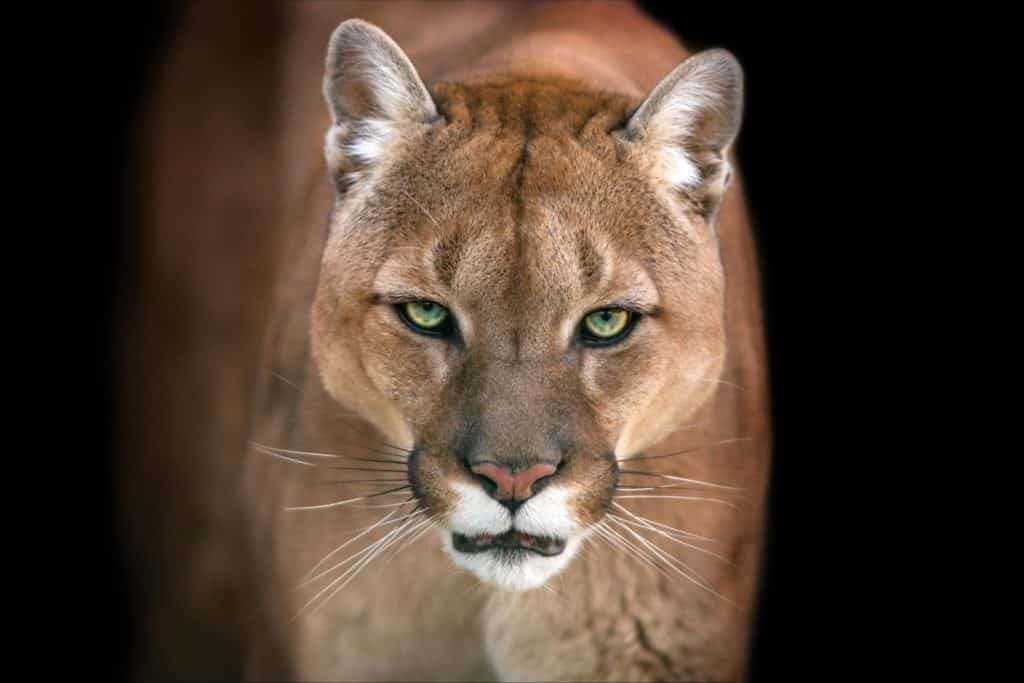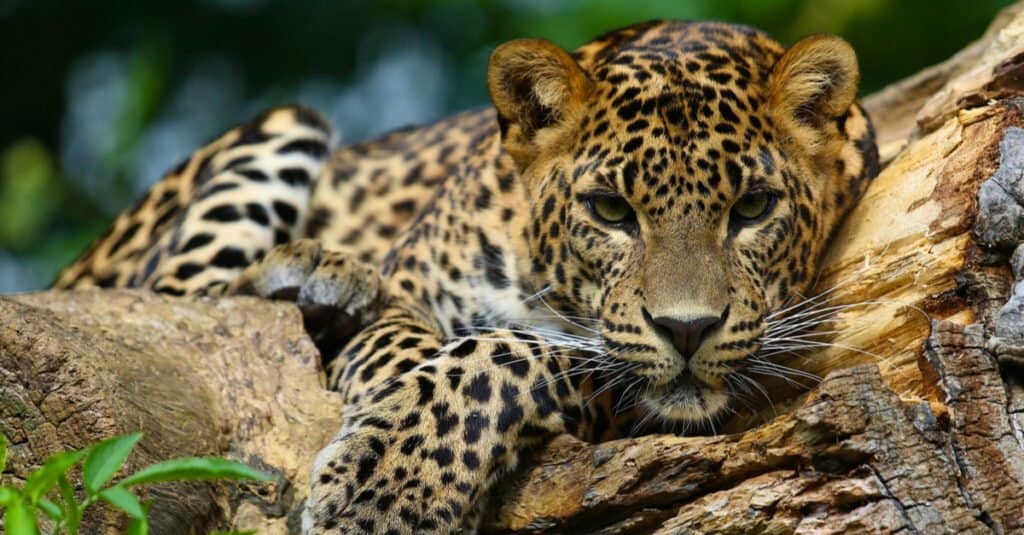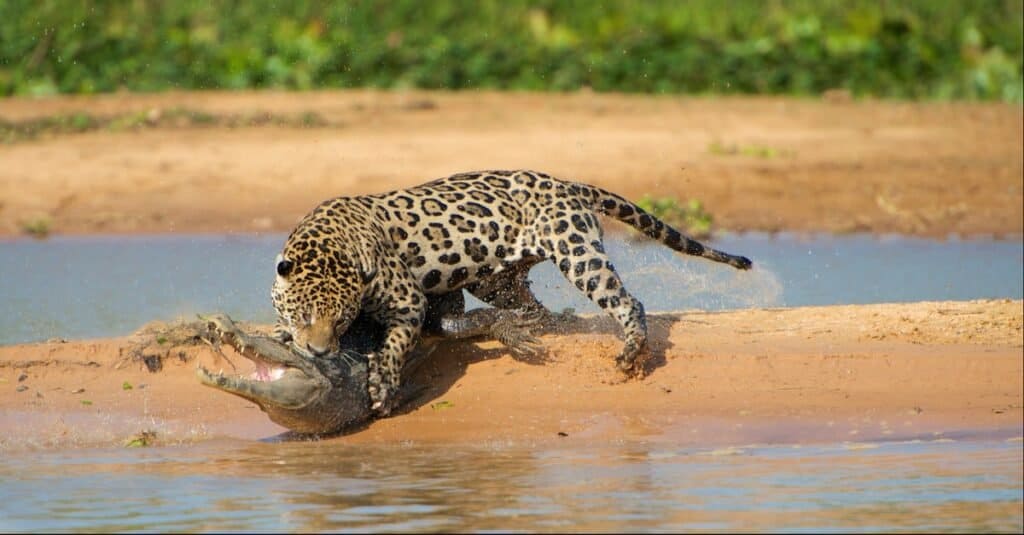Puma vs Jaguar: Mountain Feline and Jungle Cat
@media (min-width: 481px) {
.mobile-top-content {
display: none;
}
}
#mobileTopContentCTACarouselControls { overflow: hidden; text-overflow: ellipsis; white-space: nowrap; }
.mobile-top-content .more { color: #fff; }
.mobile-top-content a { color: #fff; text-decoration: underline; }
.mobile-top-content a:hover { color: #fff; text-decoration: underline; }
@media (max-width: 480px) {
.mobile-top-content {
background-color: #06a10b;
color: #fff;
text-align: center;
/*height: 60px;
padding-top:5px;*/
font-size:80%;
/* display: block; */
margin: 0px -30px;
}
}

A-Z-Animals.com
Who does not love nature’s big cats? When exploring the difference between the puma vs the jaguar, these two large felines give us plenty to work with! The biggest difference between the puma vs the jaguar is obviously the jaguar’s signature spots. Pumas, or mountain lions or cougars, have solid tan fur overall. But this really is just the beginning, there are many unique differences between the jungle cat and the North American native!
Puma VS Jaguar: Physical Characteristics
Did you know that pumas have more names than any other animal? Painters, cougars, and mountain lions, are all the same species! But jaguars are different because there are ten subspecies! That is not the only difference between them, because these two big cats are impossible to confuse with each other. What are the main physical characteristics that identify jaguars and pumas?
button.pulse {
transform: scale(1); animation: pulse 2s infinite;
box-shadow: 0 0 0 0 rgba(11, 247, 25, 1);
}
@keyframes pulse {
0% { transform: scale(0.90); box-shadow: 0 0 0 0 rgba(11, 247, 25, 0.5); }
60% { transform: scale(1); box-shadow: 0 0 0 15px rgba(11, 247, 25, 0); }
100% { transform: scale(0.90); box-shadow: 0 0 0 0 rgba(11, 247, 25, 0); }
}
Physical Characteristics Of The Puma

Kwadrat/Shutterstock.com
- Pumas are 43-78 inches long and weigh up to 231 pounds on average.
- Cougar species have coats that are often a solid color over the whole body. Coloration varies by location and can be brown, grey, yellow, or red.
- Though the puma is thought to descend from smaller feline species, they can reach sizes larger than many of the ‘true’ big cats.
- Pumas are incredibly powerful, with heavily muscular bodies and thick fur to protect them from freezing temperatures.
- Pumas have strong legs, and their hind legs are longer. This grants them enhanced agility and the ability to leap impressively long distances.
- Their massive paws are larger in proportion to their overall size, granting them enhanced stability.
- Cougars have keen hearing, and their sharp eyesight can detect prey in the darkest conditions.
- Pumas can swim, and have an average running speed of up to 30 mph.
- The cougar is not classified as a true big cat because they lack the ability to roar. Instead, pumas use their iconic scream to ward off other cougars. The trade-off? Pumas can purr!
Physical Characteristics Of The Jaguar

L-N/Shutterstock.com
- Some jaguars have brown spots on a black coat, which can make the spots hard to see.
- Jaguars do not breed well in captivity.
- The largest jaguar on record weighed 328 pounds!
- A jaguar can reach speeds up to 50 mph.
- Jaguars have a sleek but heavily muscled body that is powerful and agile.
- The jaguar has the strongest bite force to weight ratio, 1,500 psi.
- There are ten species of jaguars that are currently recognized.
- Each jaguar has a distinct pattern of darker rosettes on their dark yellow or tan fur. These patterns are unique to each jaguar, like a human’s fingerprints.
- Their rosettes act as the perfect camouflage, blending seamlessly into their surroundings.
- They are one of the most skilled swimmers among the big cats. Jaguars are as agile in the water as on land.
Puma VS Jaguar: Habitat And Behavior
Okay, so cougars and jaguars are both big, tough, and agile cats. It is going to take more than physical prowess to tell which of these felines takes the win. Would these two ever meet in the wild? And what hunting and defense skills do each bring to the table? We’ve heard all about physical ability, but how do these cats use all that power?
Habitat And Behaviors Common For The Puma

Christina Moraes/Shutterstock.com
Pumas are found throughout North, Central, and South America. They thrive in a wide variety of environments and are very secretive. Other habitat and behaviors common for cougars are:
- Pumas are highly adaptable and can thrive in any habitat. This includes mountains, jungles, grasslands, or even the desert.
- Pumas are completely solitary animals except for mating season and mothers raising cubs.
- A cougars territory varies by season and ranges from 40 to 80 square miles.
- Pumas are capable hunters both in daylight and at night. Much like a housecat, pumas tend to hunt when and where prey is available.
- Cougars are exclusively carnivorous that hunt a wide variety of prey. A smaller animal like a mouse or larger prey like goats or livestock are all fair game.
- Pumas are incredibly agile and intelligent and can run fast enough to easily overwhelm their prey.
- While the puma is not afraid of many other predators, they are attacked occasionally by packs of wolves. A puma will face down another puma with ease but is known to run from the barking of small dogs!
Habitat And Behaviors Common For The Jaguar

Gurkan Ozturk/Shutterstock.com
Jaguars are solitary hunters found in Central and South America. Jaguars prefer jungle or forest habitats and hunt primarily at night. Other habitat and behavior commonly found in jaguars are:
- Jaguars thrive in rainforest habitats with large water sources. They prefer swampland or seasonally flooded forests.
- They prefer to spend most of their time in tall trees when at rest.
- Jaguars prefer to hunt in the dense undergrowth to better camouflage themselves.
- The jaguar is an extremely skilled swimmer and moves with speed and agility in the water.
- Jaguars are fiercely territorial and outside of mating will fight each other to the death.
- The jaguar stalks and ambushes prey and is known to kill with one bite.
- Jaguars prey on over eighty distinct species to maintain their voracious appetites.
- The jaguar is one of the most aggressive species known to man and is one of the world’s most dangerous predators.
If A Puma And Jaguar Fight, Who Would Win?
Though the puma is a real contender for any other predator, the jaguar has more strength, speed, and a deadly bite force. In a fight, the jaguar would have a real fight on its hands with the puma. However, jaguars are known to be insanely aggressive and relentless when defending their territory. While there is a chance the puma could overcome that deadly bite, our money is on the jaguar!
More from A-Z Animals
.more-snake-card-image { max-height:140px !important; }
@media (min-width: 481px) {
.mobile-top-content {
display: none;
}
}
#mobileTopContentCTACarouselControls { overflow: hidden; text-overflow: ellipsis; white-space: nowrap; }
.mobile-top-content .more { color: #fff; }
.mobile-top-content a { color: #fff; text-decoration: underline; }
.mobile-top-content a:hover { color: #fff; text-decoration: underline; }
@media (max-width: 480px) {
.mobile-top-content {
background-color: #06a10b;
color: #fff;
text-align: center;
/*height: 60px;
padding-top:5px;*/
font-size:80%;
/* display: block; */
margin: 0px -30px;
}
}

A-Z-Animals.com
Who does not love nature’s big cats? When exploring the difference between the puma vs the jaguar, these two large felines give us plenty to work with! The biggest difference between the puma vs the jaguar is obviously the jaguar’s signature spots. Pumas, or mountain lions or cougars, have solid tan fur overall. But this really is just the beginning, there are many unique differences between the jungle cat and the North American native!
Puma VS Jaguar: Physical Characteristics
Did you know that pumas have more names than any other animal? Painters, cougars, and mountain lions, are all the same species! But jaguars are different because there are ten subspecies! That is not the only difference between them, because these two big cats are impossible to confuse with each other. What are the main physical characteristics that identify jaguars and pumas?
button.pulse {
transform: scale(1); animation: pulse 2s infinite;
box-shadow: 0 0 0 0 rgba(11, 247, 25, 1);
}
@keyframes pulse {
0% { transform: scale(0.90); box-shadow: 0 0 0 0 rgba(11, 247, 25, 0.5); }
60% { transform: scale(1); box-shadow: 0 0 0 15px rgba(11, 247, 25, 0); }
100% { transform: scale(0.90); box-shadow: 0 0 0 0 rgba(11, 247, 25, 0); }
}
Physical Characteristics Of The Puma

Kwadrat/Shutterstock.com
- Pumas are 43-78 inches long and weigh up to 231 pounds on average.
- Cougar species have coats that are often a solid color over the whole body. Coloration varies by location and can be brown, grey, yellow, or red.
- Though the puma is thought to descend from smaller feline species, they can reach sizes larger than many of the ‘true’ big cats.
- Pumas are incredibly powerful, with heavily muscular bodies and thick fur to protect them from freezing temperatures.
- Pumas have strong legs, and their hind legs are longer. This grants them enhanced agility and the ability to leap impressively long distances.
- Their massive paws are larger in proportion to their overall size, granting them enhanced stability.
- Cougars have keen hearing, and their sharp eyesight can detect prey in the darkest conditions.
- Pumas can swim, and have an average running speed of up to 30 mph.
- The cougar is not classified as a true big cat because they lack the ability to roar. Instead, pumas use their iconic scream to ward off other cougars. The trade-off? Pumas can purr!
Physical Characteristics Of The Jaguar

L-N/Shutterstock.com
- Some jaguars have brown spots on a black coat, which can make the spots hard to see.
- Jaguars do not breed well in captivity.
- The largest jaguar on record weighed 328 pounds!
- A jaguar can reach speeds up to 50 mph.
- Jaguars have a sleek but heavily muscled body that is powerful and agile.
- The jaguar has the strongest bite force to weight ratio, 1,500 psi.
- There are ten species of jaguars that are currently recognized.
- Each jaguar has a distinct pattern of darker rosettes on their dark yellow or tan fur. These patterns are unique to each jaguar, like a human’s fingerprints.
- Their rosettes act as the perfect camouflage, blending seamlessly into their surroundings.
- They are one of the most skilled swimmers among the big cats. Jaguars are as agile in the water as on land.
Puma VS Jaguar: Habitat And Behavior
Okay, so cougars and jaguars are both big, tough, and agile cats. It is going to take more than physical prowess to tell which of these felines takes the win. Would these two ever meet in the wild? And what hunting and defense skills do each bring to the table? We’ve heard all about physical ability, but how do these cats use all that power?
Habitat And Behaviors Common For The Puma

Christina Moraes/Shutterstock.com
Pumas are found throughout North, Central, and South America. They thrive in a wide variety of environments and are very secretive. Other habitat and behaviors common for cougars are:
- Pumas are highly adaptable and can thrive in any habitat. This includes mountains, jungles, grasslands, or even the desert.
- Pumas are completely solitary animals except for mating season and mothers raising cubs.
- A cougars territory varies by season and ranges from 40 to 80 square miles.
- Pumas are capable hunters both in daylight and at night. Much like a housecat, pumas tend to hunt when and where prey is available.
- Cougars are exclusively carnivorous that hunt a wide variety of prey. A smaller animal like a mouse or larger prey like goats or livestock are all fair game.
- Pumas are incredibly agile and intelligent and can run fast enough to easily overwhelm their prey.
- While the puma is not afraid of many other predators, they are attacked occasionally by packs of wolves. A puma will face down another puma with ease but is known to run from the barking of small dogs!
Habitat And Behaviors Common For The Jaguar

Gurkan Ozturk/Shutterstock.com
Jaguars are solitary hunters found in Central and South America. Jaguars prefer jungle or forest habitats and hunt primarily at night. Other habitat and behavior commonly found in jaguars are:
- Jaguars thrive in rainforest habitats with large water sources. They prefer swampland or seasonally flooded forests.
- They prefer to spend most of their time in tall trees when at rest.
- Jaguars prefer to hunt in the dense undergrowth to better camouflage themselves.
- The jaguar is an extremely skilled swimmer and moves with speed and agility in the water.
- Jaguars are fiercely territorial and outside of mating will fight each other to the death.
- The jaguar stalks and ambushes prey and is known to kill with one bite.
- Jaguars prey on over eighty distinct species to maintain their voracious appetites.
- The jaguar is one of the most aggressive species known to man and is one of the world’s most dangerous predators.
If A Puma And Jaguar Fight, Who Would Win?
Though the puma is a real contender for any other predator, the jaguar has more strength, speed, and a deadly bite force. In a fight, the jaguar would have a real fight on its hands with the puma. However, jaguars are known to be insanely aggressive and relentless when defending their territory. While there is a chance the puma could overcome that deadly bite, our money is on the jaguar!









